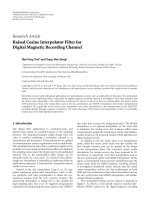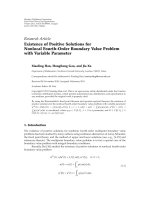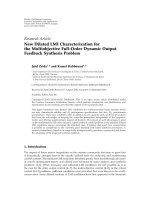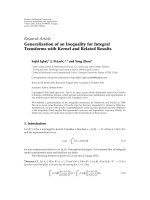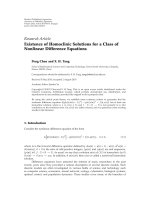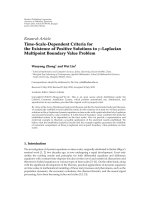Báo cáo hóa học: " Research Article Generalizations of Shafer-Fink-Type Inequalities for the Arc Sine Function" pot
Bạn đang xem bản rút gọn của tài liệu. Xem và tải ngay bản đầy đủ của tài liệu tại đây (466.68 KB, 6 trang )
Hindawi Publishing Corporation
Journal of Inequalities and Applications
Volume 2009, Article ID 705317, 6 pages
doi:10.1155/2009/705317
Research Article
Generalizations of Shafer-Fink-Type Inequalities
for the Arc Sine Function
Wenhai Pan and Ling Zhu
Department of Mathematics, Zhejiang Gongshang University, Hangzhou, Zhejiang 310018, China
Correspondence should be addressed to Ling Zhu,
Received 29 December 2008; Revised 9 March 2009; Accepted 28 April 2009
Recommended by Sever Dragomir
We give some generalizations of Shafer-Fink inequalities, and prove these inequalities by using a
basic differential method and l’Hospital’s rule for monotonicity.
Copyright q 2009 W. Pan and L. Zhu. This is an open access article distributed under the Creative
Commons Attribution License, which permits unrestricted use, distribution, and reproduction in
any medium, provided the original work is properly cited.
1. Introduction
Shafer see Mitrinovic and Vasic 1, page 247 gives us a result as follows.
Theorem 1.1. Let x>0. Then
arcsinx>
6
√
1 x −
√
1 − x
4
√
1 x
√
1 − x
>
3x
2
√
1 − x
2
. 1.1
The theorem is generalized by Fink 2 as follows.
Theorem 1.2. Let 0 ≤ x ≤ 1. Then
3x
2
√
1 − x
2
≤ arcsinx ≤
πx
2
√
1 − x
2
. 1.2
Furthermore, 3 and π are the best constants in 1.2.
In 3, Zhu presents an upper bound for arcsin x and proves the following result.
2 Journal of Inequalities and Applications
Theorem 1.3. Let 0 ≤ x ≤ 1. Then
3x
2
√
1 − x
2
≤
6
√
1 x −
√
1 − x
4
√
1 x
√
1 − x
≤ arcsinx
≤
π
√
2 1/2
√
1 x −
√
1 − x
4
√
1 x
√
1 − x
≤
πx
2
√
1 − x
2
.
1.3
Furthermore, 3 and π, 6 and π
√
2 1/2 are the best constants i n 1.3.
Malesevic 4–6 obtains the following inequality by using λ-method and computer
separately.
Theorem 1.4. Let 0 ≤ x ≤ 1. Then
arcsinx ≤
π
2 −
√
2
/
π − 2
√
2
√
1 x −
√
1 − x
√
2
4 − π
/
π − 2
√
2
√
1 x
√
1 − x
≤
π/
π − 2
x
2/
π − 2
√
1 − x
2
. 1.4
Zhu 7, 8 offers some new simple proofs of inequality 1.4 by L’Hospital’s rule for
monotonicity.
In this paper, we give some generalizations of these above results and obtain two new
Shafer-Fink type double inequalities as follows.
Theorem 1.5. Let 0 ≤ x ≤ 1, and a, b
1
,b
2
> 0.If
a, b
1
,b
2
∈
a ≥ 3,b
1
≥ a − 1,b
2
≤
2a
π
3 >a>
π
π − 2
,b
2
≤
2a
π
,b
1
≥
a sin t
a
t
a
− cost
a
π
π − 2
≥ a>
π
2
4
,b
2
≤ a − 1,b
1
≥
a sin t
a
t
a
− cost
a
π
2
4
≥ a>1,b
1
≥
2a
π
,b
2
≤ a − 1
,
1.5
then
ax
b
1
√
1 − x
2
≤ arcsin x ≤
ax
b
2
√
1 − x
2
1.6
holds, where t
a
is a point in 0,π/2 and satisfies at
a
cost
a
− sint
a
t
2
a
sint
a
0.
Journal of Inequalities and Applications 3
Theorem 1.6. Let 0 ≤ x ≤ 1, and c, d
1
,d
2
> 0. If
c, d
1
,d
2
∈
c ≥ 6,d
1
≥ c − 2,d
2
≤
√
2
2c
π
− 1
⎧
⎨
⎩
6 >c>
π
2 −
√
2
π − 2
√
2
,d
2
≤
√
2
2c
π
− 1
,d
1
≥
c sin t
c
t
c
− 2cos t
c
⎫
⎬
⎭
⎧
⎨
⎩
π
2 −
√
2
π − 2
√
2
≥ c>
π
2
8 − 2π
,d
2
≤ c − 2,d
1
≥
c sin t
c
t
c
− 2cos t
c
⎫
⎬
⎭
π
2
8 − 2π
≥ c>2,d
1
≥
√
2
2
4c
π
− 2
,d
2
≤ c − 2
,
1.7
then
c
√
1 x −
√
1 − x
d
1
√
1 x
√
1 − x
≤ arcsinx ≤
c
√
1 x −
√
1 − x
d
2
√
1 x
√
1 − x
1.8
holds, where t
c
is a point in 0,π/4 and satisfies ct
c
cost
c
− sint
c
2t
2
c
sint
c
0.
2. One Lemma: L’Hospital’s Rule for Monotonicity
Lemma 2.1 see 9–15. Let f, g : a, b → R be two continuous functions which are differentiable
and g
/
0 on a, b. If f
/g
is increasing (or decreasing) on a, b, t hen the functions fx −
fb/gx − gb and fx − fa/gx − ga are also i ncreasing (or decreasing) on a, b.
3. Proofs of Theorems 1.5 and 1.6
A We first process the proof of Theorem 1.5.
Let x sin t for x ∈ 0, 1, in which case the proof of Theorem 1.5 can be completed
when proving that the double inequality
b
1
a
≥
sin t
t
−
cos t
a
≥
b
2
a
3.1
holds for t ∈ 0,π/2.
Let Ftsint/t − cos t/a, we have
F
t
t cos t − sin t
t
2
sin t
a
sin t
t cos t − sin t
t
2
sin t
1
a
:sint
H
t
1
a
, 3.2
where Htt cos t − sin t/t
2
sin t: f
1
t/g
1
t and f
1
tt cos t − sin t, g
1
tt
2
sin t,
f
1
00, g
1
00.
4 Journal of Inequalities and Applications
Since f
1
t/g
1
t−t sin t/2t sin t t
2
cos t−1/2 t/tant decreases on
0,π/2,weobtainthatHt decreases on 0,π/2 by using Lemma 2.1. At the same time,
H0 0−1/3, Hπ/2−4/π
2
,andF0 01 − 1/a, Fπ/22/π.
There are four cases to consider.
Case 1 (a ≥ 3)
Since F
t ≤ 0, Ft decreases on 0,π/2,andinf
x∈0,π/2
Ft2/π,sup
x∈0,π/2
Ft1 −
1/a. So when b
1
≥ a − 1andb
2
≤ 2a/π, 3.1 and 1.6 hold.
Case 2 (3 >a>π/π − 2)
At this moment, there exists a number t
a
∈ 0,π/2 such that at
a
cos t
a
−sint
a
t
2
a
sin t
a
0,
F
t is positive on 0,t
a
and negative on t
a
,π/2.Thatis,Ft firstly increases on 0,t
a
then
decreases on t
a
,π/2,andinf
x∈0,π/2
Ft2/π,sup
x∈0,π/2
FtFt
a
. So when b
2
≤ 2a/π
and b
1
≥ a sin t
a
/t
a
− cos t
a
, 3.1 and 1.6 hold.
Case 3 (π/π − 2 ≥ a>π
2
/4)
Now, Ft also firstly increases on 0,t
a
then decreases on t
a
, 2/π,andinf
x∈0,π/2
Ft
1 −1/a,sup
x∈0,π/2
FtFt
a
. So when b
2
≤ a −1andb
1
≥ a sin t
a
/t
a
−cos t
a
, 3.1 and 1.6
hold too.
Case 4 (π
2
/4 ≥ a>1
Since F
t ≥ 0, Ft increases on 0,π/2,inf
x∈0,π/2
Ft1−1/a,andsup
x∈0,π/2
Ft2/π.
So when b
1
≥ 2a/π and b
2
≤ a − 1, 3.1 and 1.6 hold.
B Now we consider proving Theorem 1.6.
In view of the fact that 1.8 holds for x 0, we suppose that 0 <x≤ 1 in the following.
First, let
√
1 x
√
2 cos α and
√
1 − x
√
2sinα for x ∈ 0, 1, we have x cos 2α and
α ∈ 0,π/4. Second, let α π/4 π/2 − t, then t ∈ 0,π/4 and 1.8 is equivalent to
d
1
c
≥
sin t
t
−
2 cos t
c
≥
d
2
c
. 3.3
When letting c 2a and d
i
2b
i
i 1, 2, 3.3 becomes 3.1.
Let Ftsin t/t−cos t/a. At this moment, Ht decreases on 0,π/4, H00−1/3,
Hπ/4−1 − π/416/π
2
,andF0 01 − 2/c, Fπ/4
√
22/π − 1/c.
There are four cases to consider too.
Case 1 (c ≥ 6)
Since F
t ≤ 0, Ft decreases on 0,π/4,andinf
x∈0,π/4
Ft
√
22/π − 1/c,
sup
x∈0,π/4
Ft1 − 2/c.Ifd
1
≥ c − 2andd
2
≤
√
22c/π − 1, then 3.1 holds on 0,π/4
and 1.8 holds.
Journal of Inequalities and Applications 5
Case 2 (6 >c>π2 −
√
2/π − 2
√
2
At this moment, there exists a number t
a
∈ 0,π/4 such that at
c
cos t
c
−sin t
c
2t
2
c
sin t
c
0,
F
t is positive on 0,t
c
and negative on t
c
,π/4.Thatis,Ft firstly increases on 0,t
c
then decreases on t
c
,π/4,andinf
x∈0,π/4
Ft
√
22/π − 1/c,sup
x∈0,π/4
FtFt
c
.
If d
2
≤
√
22c/π − 1 and d
1
≥ c sin t
c
/t
c
− 2 cos t
c
, then 3.1 holds on 0,π/4 and 1.8
holds.
Case 3 (π2 −
√
2/π − 2
√
2 ≥ c>π
2
/8 − 2π
Now, Ft also firstly increases on 0,t
c
then decreases on t
c
,π/4,andinf
x∈0,π/4
Ft
1 − 2/c,sup
x∈0,π/4
FtFt
c
.Ifd
2
≤ c − 2andd
1
≥ c sin t
c
/t
c
− 2 cos t
c
, then 3.1 holds
on 0,π/4 and 1.8 holds too.
Case 4 (π
2
/8 − 2π ≥ c>2
Since F
t ≥ 0, Ft increases on 0,π/4,inf
x∈0,π/4
Ft1 − 2/c,andsup
x∈0,π/4
Ft
√
22/π − 1/c.Ifd
1
≥
√
22c/π − 1 and d
2
≤ c − 2, then 3.1 holds on 0,π/4 and 1.8
holds.
4. The Special Cases of Theorems 1.5 and 1.6
1 Taking a 3,b
1
a − 1 2 in Theorem 1.5 and c 6,d
1
c − 2 4 in Theorem 1.6
leads to the inequality 1.1.
2 Taking a π/π −2,b
2
a−1 2/π −2 in Theorem 1.5 and c π2−
√
2/π −
2
√
2,d
2
c −2
√
24 −π/π −2
√
2 in Theorem 1.6 leads to the inequality 1.4.
3 Let a π
2
/4,b
1
2/πa π/2 in Theorem 1.5 and c π
2
/24 − π,d
1
2
√
2/πc −
√
2 2
√
2π − 2/4 − π in Theorem 1.6, we have the following result.
Theorem 4.1. Let 0 ≤ x ≤ 1.Then
π
2
/4
x
π/2
√
1 − x
2
≤
π
2
/
8 − 2π
√
1 x −
√
1 − x
2
√
2
π − 2
/
4 − π
√
1 x
√
1 − x
≤ arcsinx. 4.1
Furthermore, π
2
/4 and π/2, π
2
/8 − 2π and 2
√
2π − 2/4 − π are the best constants in 4.1.
References
1 D. S. Mitrinovi
´
c and P. M. Vasic, Analytic Inequalities, vol. 16 of Grundlehren der mathematischen
Wissenschaften, Springer, New York, NY, USA, 1970.
2 A. M. Fink, “Two Inequalities,” Publikacije Elektrotehni
ˇ
ckog Fakulteta Univerzitet u Beogradu. Serija
Matematika, vol. 6, pp. 48–49, 1995.
3 L. Zhu, “On Shafer-Fink inequalities,” Mathematical Inequalities & Applications, vol. 8, no. 4, pp. 571–
574, 2005.
4 B. J. Male
ˇ
sevi
´
c, “One method for proving inequalities by computer,” Journal of Inequalities and
Applications, vol. 2007, Article ID 78691, 8 pages, 2007.
6 Journal of Inequalities and Applications
5 B. J. Male
ˇ
sevi
´
c, “An application of λ-method on inequalities of Shafer-Fink’s type,” Mathematical
Inequalities & Applications, vol. 10, no. 3, pp. 529–534, 2007.
6 B. J. Male
ˇ
sevi
´
c, “Some improvements of one method for proving inequalities by computer,” preprint,
2007, />7 L. Zhu, “On Shafer-Fink-type inequality,” Journal of Inequalities and Applications, vol. 2007, Article ID
67430, 4 pages, 2007.
8 L. Zhu, “New inequalities of Shafer-Fink type for arc hyperbolic sine,” Journal of Inequalities and
Applications, vol. 2008, Article ID 368275, 5 pages, 2008.
9 G. D. Anderson, M. K. Vamanamurthy, and M. Vuorinen, “Inequalities for quasiconformal mappings
in space,” Pacific Journal of Mathematics, vol. 160, no. 1, pp. 1–18, 1993.
10 G. D. Anderson, M. K. Vamanamurthy, and M. K. Vuorinen, Conformal Invariants, Inequalities, and
Quasiconformal Maps, Canadian Mathematical Society Series of Monographs and Advanced Texts,
John Wiley & Sons, New York, NY, USA, 1997.
11 G. D. Anderson, S L. Qiu, M. K. Vamanamurthy, and M. Vuorinen, “Generalized elliptic integrals
and modular equations,” Pacific Journal of Mathematics, vol. 192, no. 1, pp. 1–37, 2000.
12 I. Pinelis, “L’Hospital type results for monotonicity, with applications,” Journal of Inequalities in Pure
and Applied Mathematics, vol. 3, no. 1, article 5, pp. 1–5, 2002.
13 L. Zhu, “Sharpening Jordan’s inequality and the Yang Le inequality,” Applied Mathematics Letters, vol.
19, no. 3, pp. 240–243, 2006.
14 D W. Niu, Z H. Huo, J. Cao, and F. Qi, “A general refinement of Jordan’s inequality and a refinement
of L. Yang’s inequality,” Integral Transforms and Special Functions, vol. 19, no. 3-4, pp. 157–164, 2008.
15 S. Wu and L. Debnath, “A generalization of L’H
ˆ
ospital-type rules for monotonicity and its
application,” Applied Mathematics Letters, vol. 22, no. 2, pp. 284–290, 2009.


